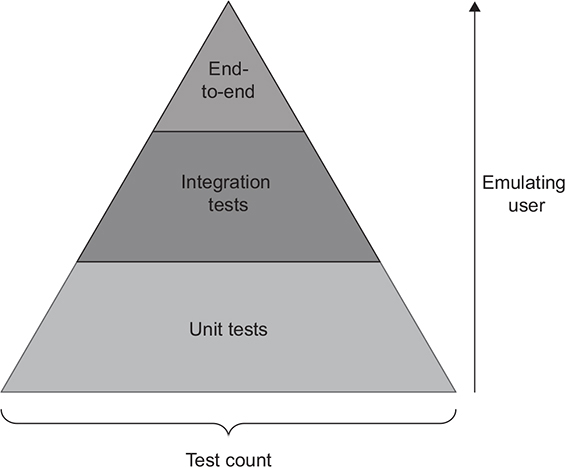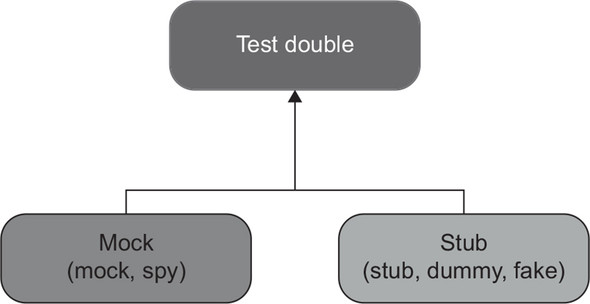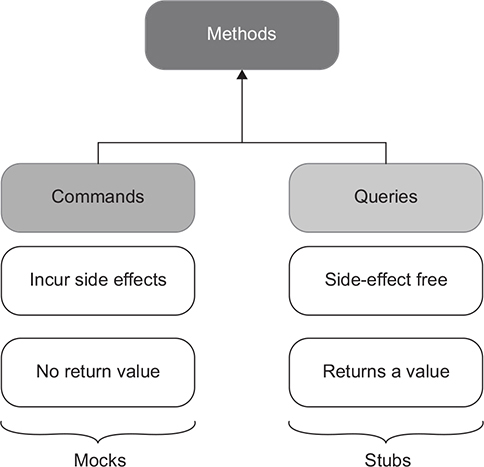- Protection againts regression
- Resistance to refactoring
- Speed (fast feedback)
The trade-off between the first three attributes of a good unit test is similar to the CAP theorem: there is the two-out-of-three trade-off.
The Test Pyramid advocates for a certain ratio of unit, integration, and end-to-end tests.
End-to-end tests favor protection against regressions, while unit tests favor fast feedback
The exact mix between types of tests will be different for each team and project. But in general, it should retain the pyramid shape: end-to-end tests should be the minority; unit tests, the majority; and integration tests somewhere in the middle.
- Black-box testing is a method of software testing that examines the functionality of a system without knowing its internal structure
- White-box testing is the opposite of that. It’s a method of testing that verifies the application’s inner workings
- Mocks help to emulate and examine outcoming interactions. These interactions are calls the SUT makes to its dependencies to change their state.
- Stubs help to emulate incoming interactions. These interactions are calls the SUT makes to its dependencies to get input data
- Mocks help to emulate and examine interactions between the SUT(structure under test sytem) and its dependencies, while stubs only help to emulate those interactions
Mock Example:(in this example i use mock tool to do a mock test. Mock tools is diffrent with mock. It’s important not to conflate a mock (the tool) with a mock (the test double) because you can use a mock (the tool) to create both types of test doubles: mocks and stubs. )
def first_char(str)
str.first
end
test 'first chart' do
object = mock('astring')
str.expects(:first).returns('a').at_least_once # verify call is mock test double
first_char(str)
endThe example above is white box testing and use Mock test double. If I change implementation to str[0] the test will be failed => the test code is not resistance to refactoring.
Stub Example 1: In this example i use fake object. And this test is black-box testing
def first_char(str)
str.first
end
test 'first chart' do
a_fake_string = 'abc'
assert_equal 'a', first_char(str)
endStub Example 2:
def say_hello(user)
"Hello #{user.name}!"
end
test "say hello" do
user = stub(name: "Quy")
aseert_equal "Hello Quy!", say_hello(user)
end1.Output-based testing: In output-based testing, tests verify the output the system generates. This style of testing assumes there are no side effects and the only result of the SUT’s work is the value it returns to the caller.
def first_char(str)
str.first
end
test 'first chart' do
a_fake_string = 'abc'
assert_equal 'a', first_char(str)
end2.State-based testing: is about verifying the state of the system after an operation is complete
Example:
def create_product(attr)
Product.new(attr).save
end
test "creating product" do
assert_diffrent "Product.count", +1 do
create_product({name: "Samsung Galaxy"})
end
end3.Communication-based testing: This style uses mocks to verify communications between the system under test and its collaborators
Example:
def notify_user(user)
Mailer.send_message(user).deliver
end
test "notify user" do
user = create(:user)
Mailer.expects(:send_message).with(user).at_least_once
notify_user(user)
end- Choose black-box testing over white-box testing by default.
- Resistance to refactoring is non-negotiable because whether a test possess this attribute is mostly a binary choice: the test either has resistance to refactoring or it doesn’t.
- stubs > mocks. This does not mean stubs(including
dummy,fake) is better than mocks. We may consider useMockfor following cases:- Sending email
- Call a service (webmock)
- Execute command lines (ffmpeg command)
- Observable behavior > implementation details. The only way to avoid the couple to code's implementation is to verify the end result the code produces (its observable behavior) and distance tests from implementation details as much as possible. In other words, tests must focus on the whats, not the hows
- Code is liability. Test code is liability too.
- If the test code is not resistant to refactoring, that means every time we change the code, we have to update the test. => test doesn't help us to detect if the changes cause bugs but it requires more cost to maintain


